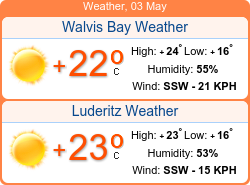About Namport
At a glance

The Namibian Ports Authority (referred to as ‘Namport’), is a state-owned enterprise, which was established by an Act of Parliament in 1994. Namport, together with its three subsidiary companies — Elgin Brown & Hamer Namibia (Pty) Ltd, Namport Property Holdings (Pty) Ltd and Lüderitz Boatyard (Pty) Ltd — are referred to as the ‘Group’.
The Port of Walvis Bay is situated on the west coast of Africa and provides an easy and fast transit route between southern Africa, Europe, Asia and the Americas.
The Port of Lüderitz, located 254 nautical miles south of the Port of Walvis Bay along Namibia’s coastline, caters for the southern part of the country, and provides access to markets in the Northern Cape of South Africa.
From its headquarters in Walvis Bay, the Namibian Ports Authority manages the Port of Walvis Bay and the Port of Lüderitz.
The stable political environment in Namibia continues to attract foreign direct investment, while its ports form a natural gateway for international trade, Strategically situated to offer direct access to principal shipping routes, Namibia’s connecting transport corridors enable the country to compete as a transport hub for all regional and international trade between the Southern African Development Community countries, Europe, Asia, the Americas and the rest of the world.
Namport’s key roles:
- Manage the port facilities to cater for current trade needs.
- Develop the ports for future demands.
- Contribute to the competitiveness of the SADC region's trade through the efficient, reliable and cost-effective supply of port services.
- Facilitate economic growth in Namibia by enabling regional development and cross-border trade.
- Promote the Ports of Walvis Bay and Lüderitz as preferred routes for sea-borne trade between SADC, Europe and the Americas.
- As the founding architects of the Walvis Bay Corridor Group, assist with developing cross-border trade.
- Minimize the impact of port operations on the natural environment by applying International Organisation for Standardisation ISO 14001.
- Uplift and support the communities in which we operate.
VESSEL TRAFFIC
On average, between 2,000 and 2,250 vessels visit the ports of Walvis Bay and Lüderitz every year, of which container vessels account for the largest number of visits.
CONTAINER CARGO HANDLING
The existing container terminal in the Port of Walvis Bay has 350,000 TEUs throughput capacity per annum. The new container terminal will increase that to 750,000 TEUs per annum.
CROSS-BORDER CARGO IMPORT/EXPORT
Namport can handle a wide range of cross-border cargo imports and exports to countries in the SADC region and beyond.
VESSEL REPAIR FACILITY
Namport manages a syncrolift with facilities that can lift vessels weighing up to 2,000 tonnes for repairs, while three Panamax floating docks with combined lifting capacity of 29,500mt are operated in partnership with EBH Namibia.
FUEL IMPORTS
Petroleum imports form the biggest share of commodities landed at the Port of Walvis Bay (34% of freight tonnes landed). Construction of a new petroleum liquid bulk terminal further north will see imports move there.
PASSENGER TRAFFIC
The New Container Terminal development makes provision for a dedicated cruise vessel berth, which will be able to accommodate larger passenger vessels, which will lead to expansion of this market.
VEHICLE TRAFFIC
The importation of new and second-hand vehicles has steadily grown and is set to increase. An area of land that can accommodate 3,500 vehicles has been identified for future growth.
COMMODITY EXPORTS
Currently, bulk and bagged salt is the biggest export commodity (46% of freight tonnage shipped), but any other commodities can be transported.
COMMODITY IMPORTS
- Sugar
- Grain
- Product cargo
GLOBAL GROWTH IN DEMAND FOR PORT SERVICES
Around 80% of global trade by volume, and over 70% of global trade by value, is seaborne. Some 90% of Africa’s imports and exports are conducted by sea. The African Development Bank has forecast that port-throughput in Africa will rise from 265 million tonnes in 2009 to more than 2 billion tonnes in 2040.
The southern African region constitutes 41% of Africa’s container throughput and is thus a critical player in the growth of the African continent.
During the past two decades, Namport has made great strides in growing in size and significance from a minor national port to a key role player in the SADC region. With its recent substantial infrastructural investment in expanding the facilities at the Port of Walvis Bay, it is set to increase its relevance even more.
EFFICIENT PORT OPERATIONS
With no delays caused by weather conditions, turnaround times at the Port of Walvis Bay are very competitive: handling times for container vessels are around 12 to 15 hours; for bulk vessels averages between 24 and 48 hours depending on tonnage and shipment; and for break-bulk vessels it average between 18 to 20 hours.
A congestion-free port with minimum delays, the Port of Walvis Bay currently handles 7 million tonnes per annum and its total capacity equips it to handle 8 to 10 million tonnes of cargo.
Currently, the roads and rail transport sub-sectors are upgrading existing roads and rail facilities to support Walvis Bay becoming the gateway port for the SADC Region. These actions will reduce transport time as well as provide alternative transport corridors connecting to our ports.
OUR SERVICES AND INDUSTRIES SERVED
The Port of Walvis Bay handles container imports, exports and transshipments, as well as bulk and break-bulk of various commodities.
Namport serves a wide range of industries such as the petroleum, salt, mining and fishing industries. Both bulk and bagged salt are exported from the Port of Walvis Bay.
The Port of Lüderitz serves the mines in the southern regions of Namibia and north-western South Africa with imports and exports of mining commodities. It is also an important base for the local fishing industry.


